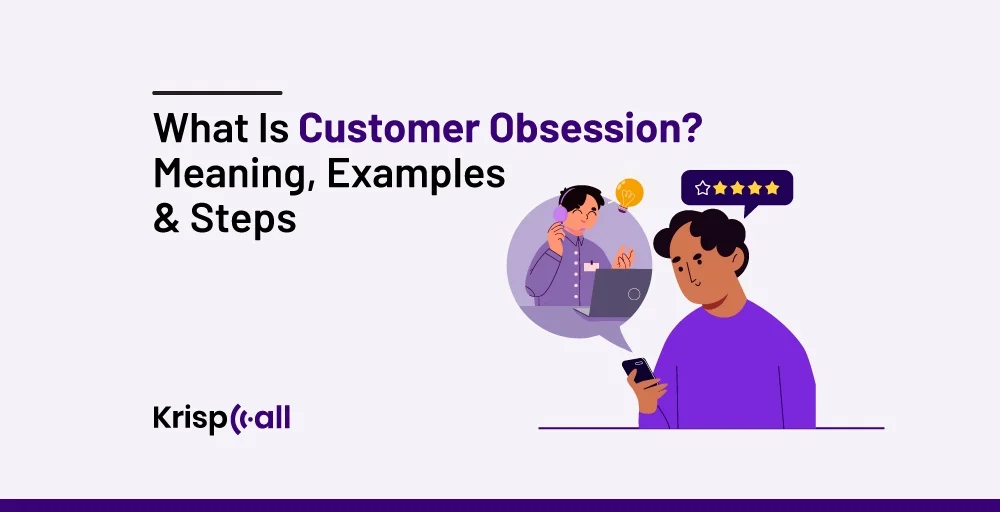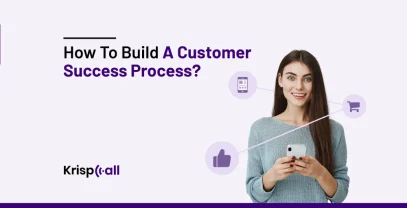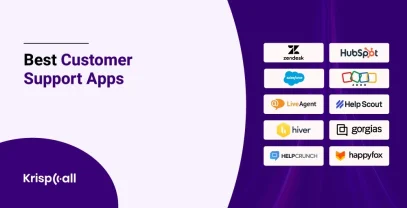Imagine a world where your customers are not just satisfied but thrilled with your service. What if every interaction left them feeling valued and understood? Customer obsession is the driving force behind this perfect scenario.
By focusing on customer obsession, businesses create loyal fans who return and promote your business. Many businesses have reported that customer obsession has increased their retention rate by 2.2x and increased their revenue by 2.5x higher.
But what exactly is customer obsession? And how it helps businesses maintain relationships with customers. Let’s find out everything about customer obsession. 🤔
🔑 KEY HIGHLIGHTS
- Customer obsession is a strategy that focuses on providing everything that customers need.
- Customer obsession is important because it allows businesses to maintain strong and lasting relationships with customers.
- Businesses such as Amazon, Starbucks, and Nordstrom have amazed the world by creating the best customer-obsession business.
- To create a customer-obsessed culture, first, you have to understand your customer base and pain points, create the strategy, and train agents.
- You can measure customer obsession using metrics like CSAT, CRR, and NPS.
What is Customer Obsession?
Customer obsession means prioritizing the customer’s needs, wants, and desires above anything else in business. This approach focuses on the tagline “customer first,” where organizations place the customer at the core of decision-making rather than solely focusing on products or services. This approach involves actively listening to customers, understanding their preferences, and gathering feedback to improve the customer experience from their perspective continuously.
When a business is customer-obsessed, it can create products, pricing structures, and payment methods based on customers’ needs and wants. Moreover, customer obsession business focuses on customers’ wants or needs, who their lead customers are, and providing a seamless experience. It encourages businesses to make efforts to understand their target customer and current customers.
Why is Customer Obsession Important?
Customer obsession is important because it helps businesses develop strategic ideas based on customers’ needs, stay competitive in the business market, transform their leadership approach, and more. In fact, if businesses adopt a customer-obsessed approach, they can grow their revenue by two times. Moreover, they will have two times higher profitability growth and customer retention.
Similarly, according to Forrester, Customer-obsessed organizations are five times more likely to offer better products and four times more likely to be profitable compared to those that aren’t.
That’s why every business’s primary goal should be customer-obsessed if they are a customer-centric business. Customers are the driving force of the business, and without them, the business can’t exist or operate.
Even many large businesses, such as Amazon, Uber, and Netflix, are customer-obsessed. These businesses are among the successful list due to their customer-centric ideas and ability to satisfy customers with their service.
Businesses can create a customer obsession method by placing customers at the center of every idea. This strategy creates customer loyalty, improves customer retention management, and satisfies customers.
Top Priorities of a Customer-Obsessed Business
Every business is different, and their strategy to create a customer-obsessed service is also different. But here are a few common priorities that every business follows;
- Caring About Customer Needs and Wants: Customer-obsessed businesses always care about what customers want or need. It’s one of their top priorities to understand what buyers need so that they can create a strategy accordingly and make them feel appreciated and satisfied with their expectations.
- Prioritizing Customer Information: Businesses prioritizing customers always keep customer information updated to provide the best service. Instead of only keeping customer information to promote or sell stuff, they use customer details to know and understand customer’s overall experience.
- Long-term Relationships: Instead of short-term relationships, businesses try to create long-lasting relationships that both loyal customers and the company need. Businesses prioritize customer satisfaction, loyalty, and retention while offering them the customer award or discounts that encourages them to repeat business.
- Improving Continuously: Every business wants to improve continuously to retain its customers and grow. To do so, they constantly seek ways to enhance the customer experience. This is why they actively gather customer feedback, monitor performance, and refine services and products.
- Personalization Communication: A customer-obsessed business always recognizes the value of personalization communication. Personalization helps organizations retain customers, build audience trust, and stay relevant. So, businesses tailor their offerings and services according to their customer base and preferences.
Customer Obsession Examples
There are thousands of customer-obsessed examples of companies that entirely focus on the customer, their experience, and their perspective. One major example is Amazon. According to Amazon’s chief executive officer (CEO) Jeff Bezos, his business model is centered around customer satisfaction, not income.
Now let’s take a look at how his business revolves around customer obsession and other few real-life examples of customer-obsessed companies;
1. Amazon
Amazon is today’s largest online retailer and technology provider. CEO Jeff Bezos says that four key core values help his company succeed. The first one is customer obsession. According to Jeff Bezos, customer obsession is by far the most effective method of distinguishing them from their competitors. They describe their strategy as “starting with the customer and working backward.” In fact, it’s one of Amazon’s core business values.
Amazon’s customer obsession identifies the core and constant needs and behavior of the customer and provides innovative solutions until they satisfy customers. For example, if the customer wants the product to be delivered fast, then Amazon tries to prioritize customers in faster shipping.
Amazon is one of the top examples of customer-obsessed companies that has also taken one step ahead in identifying future customer needs and wants based on historical data. This data helps them develop solutions to customers’ future needs and issues.
2. Starbucks
It amazes many people that Starbucks is also a customer-obsessed business. It hasn’t been that long since Starbucks has become a customer-obsessed company. It was previously known as product-focused, creating better and fancier drinks and offering different products so customers could buy their stuff.
However, in recent years, Starbucks has changed its approach from product-centric to customer-obsessed and has provided a great example for other companies to follow. They have created this app and loyalty program where customers are kept at the center of the Starbucks experience.
This app remembers customers’ orders no matter where they are ordering from. Similarly, it recommends new drinks that customers might enjoy and, based on their past purchases, schedules drinks for pickup.
3. Nordstrom
Nordstrom is another excellent example of how a business can create a model that centers around customer service and satisfaction. Nordstrom is an American department store that has been able to increase their customer retention rate through their customer-obsession strategy.
In customer-obsession, what Nordstrom does is it offers a various and different personalized service to its regular and potential customers. When you provide personalized service, it can make customers feel important and valued.
To enhance customer obsession, Nordstrom created the Nordstrom Analytical Platform (NAP) to improve service and product discovery. NAP is an AI model that predicts each customer’s preferences and shopping choices. With the help of 100 AI models, NAP can create fashion maps and also use AI natural language conversations to predict customer preference. This AI marketing has helped Nordstrom continuously dominate the retail sector.
How to Create a Customer-Obsessed Culture? 6 Steps
Creating a customer-obsessed culture requires several effective approaches, such as understanding customers, creating a customer obsession strategy, training teams, and nurturing customer obsession at every level of your organization. This approach helps businesses prioritize customers and maintain a customer-first mindset.
Here are detailed steps to create a customer-obsessed culture in your business.
1. Understand and Research your Customer
The first step in creating a customer-obsessed culture in any business is to understand and research your customer base. You have to research your ideal buyer based on current loyal customer data. This data can be based on demographic information, age, location, or job title.
Along with demographic information, you also have to understand customer pain points and goals, including customer buying habits. These kinds of customer profiles will provide a business with comprehensive information about the customer.
In addition to researching the customer, you can also communicate directly with them. You can ask for feedback on their needs, wants, or the problems they are facing so that you can provide service accordingly. And when you put customer need and their problem in front, you will eventually have a healthy long-term relationship.
2. Create a Customer Obsession Strategy
Once you have understood the customer base, it is time to create a customer obsession strategy. But first, you must sink all your organization’s processes, structure, technology, and metrics with a customer-centric approach. All these business approaches should focus on providing a customer-centric service rather than a product-centric service.
When you align the business’s approach, you can create a roadmap based on your business values and ideas. While making a strategy, always consider your purpose of adopting a customer-obsessed approach and how your business aims to grow. Similarly, you can map out your desired condition when you actually adopt a customer-obsession approach. Finally, keep in mind how customers will react or feel when you use this approach.
3. Train Your Agents
Did you know that well-trained agents can provide a better customer experience and solve problems efficiently? In addition, they can turn any negative experience into a positive one, which significantly impacts customer retention. Due to this, customers prefer agents who are trained properly and capable of solving problems.
So, to create a customer-obsessed culture, businesses must train their agents. They must invest in team training and provide them with robust customer training. You can also create a supportive work environment and give them the tools they need to do their business smoothly. Businesses can also regularly hold meetings to check their progress and receive feedback from agents about their problems.
4. Recognize and Reward Customer-obsessed Employees
One effective way to encourage certain behaviors is through positive reinforcement, which means rewarding people for doing something good. When people receive rewards, they are more likely to keep doing that behavior, which can become a habit over time.
To make your organization more focused on pleasing customers, create systems that reward employees for doing so. For example, publicly praise employees during meetings when they receive positive reviews. Also, set specific goals related to customer satisfaction, like customer retention, upselling, cross-selling, and survey scores.
5. Customer Obsession Should Be Prioritized By Top Leaders
Leaders can strongly influence their teams to focus on customers. They should talk about customer-focused ideas in meetings and include them in strategic plans. If you want employees to be customer-focused, leaders should also follow this approach in internal processes. It’s crucial to design a sales process centered on customers.
Leaders should consistently show they care about customers. They should prioritize customer needs in every discussion, share customer experience insights and data to show attention, and help others improve. Encourage teams to consider customers’ perspectives and share stories of employees who excel in customer care. Reward these actions when noticed.
6. Listen Carefully To Customer Feedback.
If you want to create a customer-obsessed culture, you have to listen carefully to gather customer feedback. When dealing with businesses, customers face many good and bad services. They might have to deal with an unhelpful agent, wait on hold for too long, or repeat the same information, and they might stop using that business.
So, to avoid this kind of situation, businesses need to start receiving and understanding customer feedback. They can do this by asking customers for their opinions through surveys, reading online reviews, talking to them, checking social media, and gathering customer feedback. Implementing best practices for Customer Feedback Management (CFM) can significantly enhance this process.
Qualities Required for Customer Obsession
- Simplicity: One quality that customer obsession should have is simplicity. Always make sure that your brand is simple for the customer. Even if your company has a complex set of rules or products, try to describe it in a simple way. This way, you can minimize customer efforts and issues and give them an effortless experience.
- Empathy: Always try to visualize the customer’s point of view and try to solve their problems by understanding their actual problems. When you empathize with the customer, you’ll be able to learn what they want and what problems they have.
- Respect: Respecting every customer is a core quality that customer obsession follows. A friendly and respectful relationship lasts for a long time. A recent report revealed that businesses that respect their customer have the highest customer satisfaction rate.
- Customer Focus: Customer obsession isn’t restricted to customer service departments. All the other departments, such as sales and marketing, should also focus on the customer. By doing so, businesses can develop a better customer obsession approach.
- Communication: Businesses with a customer-obsessed approach should maintain open, honest, and mostly transparent communication with customers. Only honest and meaningful conversations can help you understand your customers and make them feel valued.
How to Measure Customer Obsession?
Businesses can measure customer obsession using different key metrics such as CSAT, NPS, Customer retention rate, and Customer effort score.
1. Customer Retention Rate (CRR)
Customer Retention Rate (CRR) is a metric that calculates the percentage of customers businesses are able to retain. The higher the CRR, the better. It not only shows how many customers your business has acquired but also how many of them are with your business.
To calculate the customer retention rate, all you have to do is take the number of customers at the beginning of the period and subtract it from the number of customers acquired, then divide it by the number of customers at the end of the period and multiply by 100.
Its formula looks like this;
Customer retention rate = (Number of customers at the beginning of the period minus the number of customers purchased in the period) / Number of customers at the end of the period x 100%.
2. Customer Satisfaction Score (CSAT)
Customer Satisfaction Score (CSAT) is also a key metric that calculates how satisfied customers are with your business or your service. Businesses measure CSAT through different surveys and customer feedback. When the rate is calculated, the high satisfaction score suggests that you are able to satisfy customer expectations.
To calculate CSAT, first, you have to divide the number of satisfied customers by the total number of customers and then multiply it by 100%.
CSAT formula looks like this;
CSAT: (Number of satisfied customers/total number of customers) x 100%.
3. Net Promoter Score (NPS)
Net Promoter Score (NPS) is a key performance indicator that tracks customer loyalty by determining whether customers are likely to recommend a business product to others. NPS helps businesses analyze how customers feel about the products they sell and the services they provide.
So, to measure customer obsession, businesses must calculate the Net promoter score (NPS)
To calculate NPS, subtract the percentage of detractors (those who score zero-six) from the percentage of promoters (those who score nine-ten) in response to the recommendation question.
NPS formula looks like this;
NPS: ( % promoters – % detractors)
Conclusion
Customer obsession isn’t just a strategy; it’s a business philosophy that transforms customer interactions into remarkable experiences. By prioritizing customer needs, businesses see tangible results: a 2.2x increase in retention rates and a 2.5x boost in revenue. This approach creates loyal customers who champion your brand.
Companies like Amazon, Starbucks, and Nordstrom have succeeded with customer obsession. They focus on what customers need and want. This leads to happier customers and more business growth.
Ready to take your business to the next level? Start prioritizing customer obsession today!
FAQ
1. What is the difference between customer service and customer obsession?
Customer service is assistance and advice provided by the business to customers. On the other hand, customer obsession is prioritizing the customer’s needs, wants, and desires above anything else in the business.
2. What is the factor that makes you customer-obsessed?
The factor that makes you customer-obsessed is your dedication to understanding and fulfilling your customers’ needs, desires, and expectations. This commitment involves prioritizing customer feedback, actively listening to their concerns, continually refining products and services based on their insights, and ensuring that every decision revolves around improving the overall customer experience.
3. How to Handle Customer Obsession?
To handle customer obsession, focus on understanding and exceeding customer needs through continuous feedback, personalized experiences, and exceptional service. You can also train employees to prioritize customer satisfaction and maintain a customer-centric company culture.




